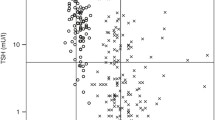Abstract
The purpose of this study was to assess how much of the variance in intellectual outcome at 2 and 6 years of age could be attributed to treatment variables in children with congenital hypothyroidism, and which of the parameters used for monitoring treatment predicted later development. Forty-five children, early treated according to general recommendations, were studied. Linear multiple regression analysis was used, controlling for socio-economic status and the pretreatment serum thyroxine concentration. At 2 years of age, 19% of the variance in Mental Development Index (Bayley Scales of Infant Development) was attributed to treatment variables: combinations of serum thyroxine and serum TSH during the 1st year and bone age at mean age 1.5 years (meanz-scores). At 6 years of age, 35% of the variance in Verbal IQ (Wechsler Preschool and Primary Scale of Intelligence) was attributed to treatment variables: 13% to the mean serum thyroxine concentration during the 1st year, 12% to the initiall-thyroxine dose per kilogram body weight per day, and 10% to a combined measure for serum thyroxine and serum TSH during the 2nd year (meanz-score).
Conclusion
Both the initiall-thyroxine dosage and treatment variables during the 1st and the 2nd year (serum thyroxine, serum TSH and bone age) predicted later intellectual outcome in children with congenital hypothyroidism.
Similar content being viewed by others
Abbreviations
- T 4 :
-
thyroxine
- TSH :
-
thyrotropin
References
American Academy of Pediatrics, American Thyroid Association (1987) Newborn screening for congenital hypothyroidism: recommended guidelines. Pediatrics 80:745–749
Bayley N (1986) Bayley Scales of Infant Development. The Psychological Corp, New York
Bongers SCJ, Colon EJ, Hoogland RA, Groot CJ de, Brande JL den (1991) Somatosensory evoked potentials in neonates with primary congenital hypothyroidism during the first week of therapy. Pediatr Res 30:34–39
Calvo R, Obregón MJ, Ruiz de Oña C, Escobar del Rey F, Morreale de Escobar G (1990) Congenital hypothyroidism, as studied in rats. Crucial role of maternal thyroxine but not of 3,5,3′-triiodothyronine in the protection of the fetal brain. J Clin Invest 86:889–899
Dubuis J-M, Richer F, Glorieux J, Deal C, Dussault JH (1994) Should all patients with congenital hypothyroidism (CH) be treated with 10–15 μg/kg/day levothyroxine (T4)? Pediatr Res 35 (4/part 2):98A
Dussault JH, Farriaux JP (1990) Early treatment for congenital hypothyroidism [Letter]. Pediatrics 85:237–238
Fisher DA, Foley BL (1989) Early treatment of congenital hypothyroidism. Pediatrics 83:785–789
Fisher DA (1990) [Letter]. Pediatrics 85:238–239
Glorieux J, Desjardins M, Letarte J, Morisette J, Dussault J (1988) Useful parameters to predicr the eventual mental outcome of hypothyroid children. Pediatr Res 24:6–8
Grant DB (1991) Monitoring TSH concentrations during treatment for congenital hypothyroidism. Arch Dis Child 66:669–671
Grant DB, Fuggle PW, Smith I (1993) Increased plasma thyroid stimulating hormone in treated congenital hypothyroidism: relation to severity of hypothyroidism, plasma thyroid hormone status, and daily dose of thyroxine. Arch Dis Child 69:555–558
Grant DB (1995) Congenital hypothyroidism: optimal mangement in the light of 15 years' experience of screening. Arch Dis Child 72:85–89
Greulich WW, Pyle SI (1959) Radiographic atlas of skeletal development of the hand and wrist. Stanford University Press, Stanford
Heyerdahl S, Kase BF (1995) The significance of elevated serum thyrotropin during treatment of congenital hypothyroidism. Acta Paediatr 84:634–638
Heyerdahl S, Kase BF, Lie SO (1991) Intellectual development in children with congenital hypothyroidism in relation to recommended thyroxine treatment. J Pediatr 118:850–857
Heyerdahl S, Kase BF, Stake G (1994) Skeletal maturation during thyroxine treatment in children with congenital hypothyroidism. Acta Paediatr 83:618–622
Kooistra L, Laane C, Vulsma T, Schellekens, Meere JJ van der, Kalverboer AF (1994) Motor and cognitive development in children with congenital hypothyroidism: A long-term evaluation of the effects of neonatal treatment. J Pediatr 124:903–909
Leslie PJ, Toft AD (1988) The replacement therapy problem in hypothyroidism. In: Lazarus JH, Hall R (eds) Baillière's clinical endocrinology and metabolism. Hypothyroidism and goitre. Baillière Tindall, London, pp 653–669
New England Congenital Hypothyroidism Collaborative (1984) Characteristics of infantile hypothyroidism discovered on neontal screening. J Pediatr 104:539–544
New England Congenital Hypothyroidism Collaborative (1990) Elementary school performance of children with congenital hypothyroidism. J Pediatr 116:27–32
New England Congenital Hypothyroidism Collaborative (1994) Correlation of cognitive test scores and adequacy of treatment in adolescents with congenital hypothyroidism. J Pediatr 124:383–387
Rovet J, Ehrlich R, Sorbara D (1987) Intellectual outcome in children with fetal hypothyriidism. J Pediatr 110:700–704
Rovet JF, Ehrlich RM, Sorbara DL (1989) Effect of thyroid hormone level on temperament in infants with congenital hypothyroidism detected by screening of neonates. J Pediatr 114:63–68
Simons WF, Fuggle PW, Grand DB, Smith I (1994) Intellectual development at 10 years in early treated congenital hypothyroidism. Arch Dis Child 71:232–234
Tillotson SL, Fuggle PW, Smith I, Ades AE, Grant DB (1994) Relation between biochemical severity and intelligence in carly treated congenital hypothyriidism: a threshold effect. BMJ 309:440–445
Toublanc JE, Rives J, Acosta A, Chicaud J (1990) Le développement psychomoteur et intellectuel chez 52 enfants atteints d'hypothyro die congénitale depistée à la naissance. Arch Fr Pediatr 47:191–195
Wechsler D (1967) Wechsler Preschool and Primary Scale of Intelligence. The Psychological Corp. New York. (Norwegian edition by Langset M. Oslo: Norsk Psykologforening, 1983.)
Author information
Authors and Affiliations
Rights and permissions
About this article
Cite this article
Heyerdahl, S. Treatment variables as predictors of intellectual outcome in children with congenital hypothyroidism. Eur J Pediatr 155, 357–361 (1996). https://doi.org/10.1007/BF01955261
Received:
Accepted:
Issue Date:
DOI: https://doi.org/10.1007/BF01955261



